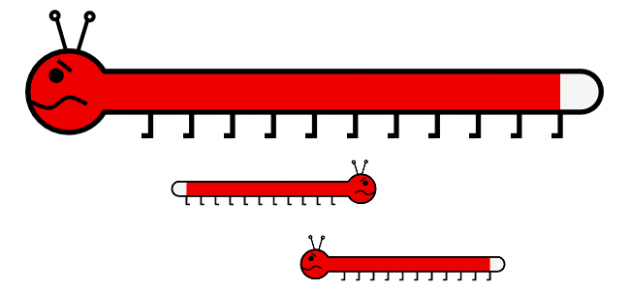Do You Have The Fever Phobic Mama Bug?
fever facts specifically for the mamas infected with fever phobia

No? Well, you may have been bitten by its cousin, the fever phobic bug. The fever phobic bug can go after anyone, but the fever phobic mama bug likes to feed on mamas. In this post, I will focus on the maternal version of this bug, but if you’ve been afflicted by its relative, read on.
Once bitten by this bug, the host is infected with fever phobia. How do you tell if you have fever phobia? Consider your answers to the following questions:
- Do you give your kid Motrin the second the thermometer reads anything above 98.6°F?
- Do you fear what could happen if your child had a “high” fever?
- Are you afraid your child will get febrile seizures if you don’t stop his or her fever?
- Are you worried your child will suffer brain damage if his fever goes “too high”?
Yeah? Worried about these things? I’m writing to shoo that fever phobic mama bug away. There are certainly things about a fever that can seem really scary, especially if you haven’t been properly educated on the facts. It’s too tempting to fear what we don’t know. What we really need to think about—are we giving our children a fever-reducing drug to medicate our own fears?
In February of this year, the American Academy of Pediatricians (AAP) released a clinical report on fevers. They found that most parents give fever reducing drugs to their kids, not only in the presence of a small fever, but even when there is no fever.1 Lack of awareness and education on the facts seem to fuel our fear-driven behavior around fevers. This same report issued by the AAP noted that about half of parents believe a fever can fall below 100.4°F, the actual fever threshold.
Fever, Defined
I’ve been dying to say this: 99°F is NOT a fever. And 100°F really isn’t a fever either. Medically speaking, a fever is not a fever until the temperature is greater than 100.4°F or 38°C. Although some sources vary by a tenth or two, this is the general rule of thumb (for all humans, kids and adults alike).
Another important thing to remember is that body temperatures fluctuate throughout the day. Its called diurnal variation. Our temperatures are lowest in the morning and highest in the evening. The same goes for kids. When it looks like little Johnny is spiking a “fever” at 99.9°F at 8pm, well, he might just be ok.
Febrile Seizures
Physiologically, febrile seizures result when the body experiences a very rapid rise in temperature over a short amount of time. The neurological system gets a little confused by this, and responds with a febrile seizure.
No doubt, febrile seizures sound terrifying, but they really aren’t as scary as they seem. In fact, they are harmless. They do not result in permanent brain damage, neurological problems, or death. They can last anywhere from a few seconds to a few minutes, and they rarely last as long as fifteen minutes. They usually occur between the temperature range of 101°F-103°F.
If you’re reading this, you certainly don’t need to worry about getting a febrile seizure the next time you let your fever ride it out— febrile seizures only occur in kids ages 6 months to 5 years old.2 If you’re 42, you’re out of the age range. But for those mamas of kiddos ages 6 months to 5 years old, you need to know that fever reducing medications like Tylenol or Motrin do not prevent febrile seizures.
If your child has a febrile seizure, even though most are benign, it is still important to get him or her checked out by your pediatrician.
When Fevers Are Serious
Although fevers are a crucial part of a healthy immune response to infection, there are fever numbers of concern.
- Fevers around 105°F-106°F usually indicate a severe bacterial infection.
- Damage to neurological tissue (the brain is a neurological tissue) is more likely once a fever hits 107°F.
- A fever in a baby less than 3 months old is always abnormal. Call your baby’s pediatrician if this occurs.
- High fevers in pregnant women are of concern. Consult your doctor or midwife ASAP if you get a high fever during pregnancy.
In this post, I discussed exactly what a fever is, that febrile seizures are benign, and the numbers you should be concerned about. You are now ready to learn about the benefits of letting a fever run its course, so stay tuned for the follow-up post. Knowing the salutary purposes of a fever will help keep that fever phobic mama bug away for good.
A large thanks to Dr. Candace Aasan and Dr. Sheila Kingsbury for being outstanding teachers of naturopathic pediatrics. Their pediatric classes have inspired me to incorporate pediatric topics into my blog.
Resources:
1 “Clinical Report Fever and Antipyretic Use in Children“. Pediatrics: Official Journal of the American Academy of Pediatrics. February 2011.
2 “Febrile Seizures”. First Consult. Online. Last Updated April 12, 2011.
3 “Fever” and “Seizure” Chapter Numbers 174 and 593, respectively, in the Nelson Textbook of Pediatrics, 18th Edition.
4 Bastyr University’s Pediatrics II Class Notes provided by Dr. Candace Aasan.
Enjoy More Archerfriendliness
I am pretty good at maintaining my health when it comes to diet and environmental chemical exposures, but when it comes to sleep, I get a "U". Just like the "U" I got in my 8th grade sewing class...
I had gum graft surgery this past March. I had put the surgery off for two years, due to the multiple inconveniences (although I wish I hadn't avoided it for so long). The biggest inconvenience fo...
When I think of cloves, the first thing that comes to my mind is a pick axe, a ginormous ant hill, and clove cigarettes. There was a kid on my first high school Africa trip who got in big trou...








Pamela
May 17th, 2011 at 9:37 am
Great Post! A little information goes a long way in keeping us parents from unnecessarily medicating our kids. Can’t wait for the follow-up post!
Reply
Lisa Brennan
May 17th, 2011 at 12:01 pm
Archer, I love reading your blog! Good Job! I agree Dr. Candace & Dr. Sheila are such inspiring leaders in the Pediatrics field.
<3 your fellow peds club leader,
Lisa
Reply
Ebun
May 17th, 2011 at 3:24 pm
This is really interesting to know because when I babysit I’m always worried when they start to feel warm and their temp is above 98.6.
Reply
Heather Traub
May 17th, 2011 at 8:36 pm
Archer ~ great blog my friend!! Thank you for putting your wisdom “out there” for others to read. I can’t wait to browse & read more! Love the set up as well. Very visually satisfying (that sounded weird, but the colors and graphics draw you in.) Thumbs up to you and Jakers!!
Reply
matt
May 19th, 2011 at 9:03 pm
hey this has helped me a little my 3 y.o daughter is in hospital now and been there for over 24 hours she seems to come good and then goes back down hill very quickly i just hope she gets better and they find out whats wrong with her from the sounds of this it might be it
Reply